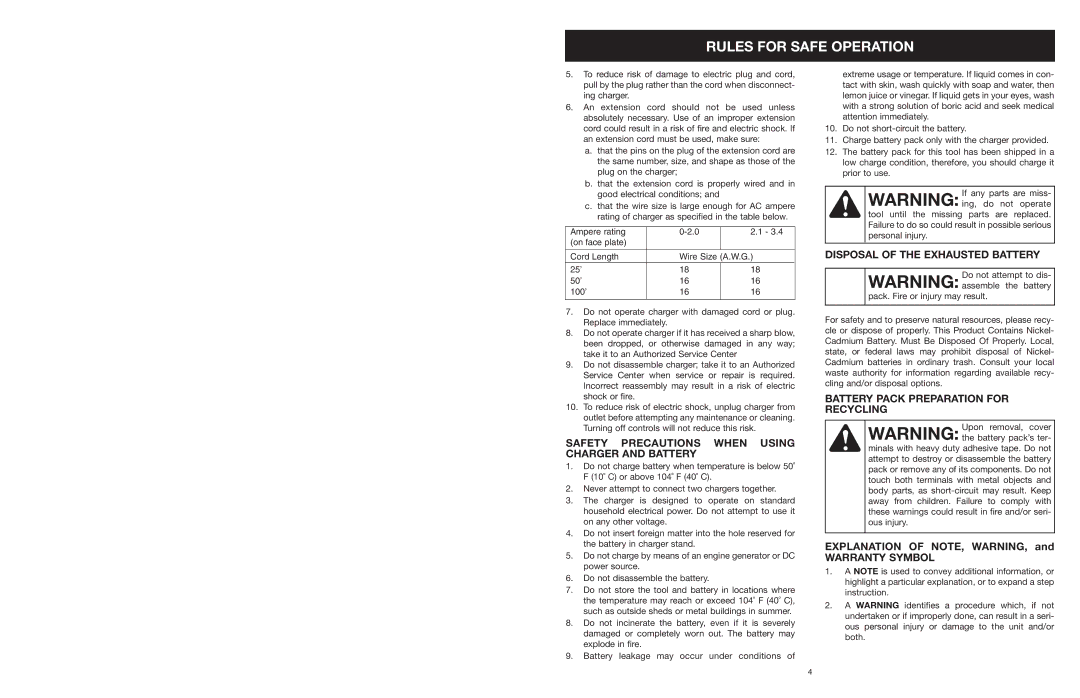
RULES FOR SAFE OPERATION
5.To reduce risk of damage to electric plug and cord, pull by the plug rather than the cord when disconnect- ing charger.
6.An extension cord should not be used unless absolutely necessary. Use of an improper extension cord could result in a risk of fire and electric shock. If an extension cord must be used, make sure:
a.that the pins on the plug of the extension cord are the same number, size, and shape as those of the plug on the charger;
b.that the extension cord is properly wired and in good electrical conditions; and
c.that the wire size is large enough for AC ampere rating of charger as specified in the table below.
Ampere rating | 2.1 - 3.4 | |
(on face plate) |
|
|
|
|
|
Cord Length | Wire Size (A.W.G.) | |
|
|
|
25’ | 18 | 18 |
50’ | 16 | 16 |
100’ | 16 | 16 |
|
|
|
7.Do not operate charger with damaged cord or plug. Replace immediately.
8.Do not operate charger if it has received a sharp blow, been dropped, or otherwise damaged in any way; take it to an Authorized Service Center
9.Do not disassemble charger; take it to an Authorized Service Center when service or repair is required. Incorrect reassembly may result in a risk of electric shock or fire.
10.To reduce risk of electric shock, unplug charger from outlet before attempting any maintenance or cleaning. Turning off controls will not reduce this risk.
SAFETY PRECAUTIONS WHEN USING CHARGER AND BATTERY
1.Do not charge battery when temperature is below 50˚ F (10˚ C) or above 104˚ F (40˚ C).
2.Never attempt to connect two chargers together.
3.The charger is designed to operate on standard household electrical power. Do not attempt to use it on any other voltage.
4.Do not insert foreign matter into the hole reserved for the battery in charger stand.
5.Do not charge by means of an engine generator or DC power source.
6.Do not disassemble the battery.
7.Do not store the tool and battery in locations where the temperature may reach or exceed 104˚ F (40˚ C), such as outside sheds or metal buildings in summer.
8.Do not incinerate the battery, even if it is severely damaged or completely worn out. The battery may explode in fire.
9.Battery leakage may occur under conditions of
extreme usage or temperature. If liquid comes in con- tact with skin, wash quickly with soap and water, then lemon juice or vinegar. If liquid gets in your eyes, wash with a strong solution of boric acid and seek medical attention immediately.
10.Do not
11.Charge battery pack only with the charger provided.
12.The battery pack for this tool has been shipped in a low charge condition, therefore, you should charge it prior to use.
If any parts are miss- WARNING: ing, do not operate
tool until the missing parts are replaced. Failure to do so could result in possible serious personal injury.
DISPOSAL OF THE EXHAUSTED BATTERY
Do not attempt to dis- WARNING: assemble the battery
pack. Fire or injury may result.
For safety and to preserve natural resources, please recy- cle or dispose of properly. This Product Contains Nickel- Cadmium Battery. Must Be Disposed Of Properly. Local, state, or federal laws may prohibit disposal of Nickel- Cadmium batteries in ordinary trash. Consult your local waste authority for information regarding available recy- cling and/or disposal options.
BATTERY PACK PREPARATION FOR RECYCLING
Upon removal, cover WARNING: the battery pack’s ter-
minals with heavy duty adhesive tape. Do not attempt to destroy or disassemble the battery pack or remove any of its components. Do not touch both terminals with metal objects and body parts, as
EXPLANATION OF NOTE, WARNING, and
WARRANTY SYMBOL
1.A NOTE is used to convey additional information, or highlight a particular explanation, or to expand a step instruction.
2.A WARNING identifies a procedure which, if not undertaken or if improperly done, can result in a seri- ous personal injury or damage to the unit and/or both.
4
